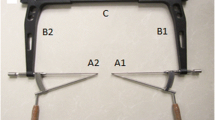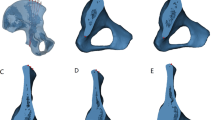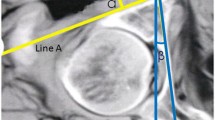Abstract
Background
Lag screw fixation has been recommended for treatment of acetabular and pelvic fracture for several years. The aim of the present study was to determine the projection of the axis of the posterior column on the inner table of the iliac wing in the supra-acetabular region.
Methods
Thirty adult dried bony hemipelves specimens and other five intact adult dried pelvic specimens were included in this study. The projection point of the axis of the posterior column of the acetabulum was determined on the inner table of the iliac wing of the hemipelves specimens. The perpendicular distance from the optimal entry point to the linea terminalis of pelvis was measured and recorded as the lateral distance. The same measurement along the linea terminalis from the optimal entry point to the junction between the anterior border of iliosacral articulation and the linea terminalis of pelvis was made and recorded as the posterior distance. The depth of the anchor path and the corresponding average retroversion angulation and extraversion angulation were also measured. According to the results acquired from this study, a series of 6.5 mm lag screws were inserted into the posterior column of each side of the other five intact specimens, respectively, to evaluate the position of the screws. The data were expressed as mean ± SD and analyzed by using the descriptive methods with SPSS 10.0.
Results
The average length of lag screw was 104.8 ± 4.2 mm. The average lateral distance was 16.8 ± 2.1 mm. The average posterior distance was 23.5 ± 3.4 mm. The corresponding average retroversion angulation and extraversion angulation were 57°36′ ± 4°28′ and 119°18′ ± 2°32′, respectively. The insertion of the single 6.5 mm lag screw of adequate length was possible in the posterior column along its anchor path and no accidental extraosseous or intraarticular screw placement had occurred.
Conclusions
The present study describes a safe anchor path of antegrade lag screw fixation in the posterior column. Insertion of the lag screws of adequate length is possible in the posterior column along its functional axis.


Similar content being viewed by others
References
Goulet JA, Bray TJ (1989) Complex acetabular fractures. Clin Orthop Relat Res 240:9–20
Schopfer A, DiAngelo D, Hearn T et al (1994) Biomechanical comparison of methods of fixation of isolated osteotomies of the posterior acetabular column. Int Orthop 18(2):96–101. doi:10.1007/BF02484418
Matta JM (1994) Operative treatment of acetabular fracture through the ilioinguinal approach. A 10-year perspective. Clin Orthop Relat Res 305:10–19. doi:10.1097/00003086-199408000-00003
Stöckle U, Hoffmann R, Nittinger M et al (2000) Screw fixation of acetabular fractures. Int Orthop 24(3):143–147. doi:10.1007/s002640000138
Brown GA, Willis MC, Firoozbakhsh K et al (2000) Computed tomography image-guided surgery in complex acetabular fractures. Clin Orthop Relat Res 370(1):219–226. doi:10.1097/00003086-200001000-00022
Stöckle U, König B, Hofstetter R et al (2001) Navigation assisted by image conversion. An experimental study on pelvic screw fixation. Unfallchirurg 104(3):215–220. doi:10.1007/s001130050717
Stöckle U, König B, Dahne M et al (2002) Computer assisted pelvic and acetabular surgery. Clinical experiences and indications. Unfallchirurg 105(10):886–892. doi:10.1007/s00113-002-0438-z
Mosheiff R, Khoury A, Weil Y et al (2004) First generation computerized fluoroscopic navigation in percutaneous pelvic surgery. J Orthop Trauma 18(2):106–111. doi:10.1097/00005131-200402000-00009
Starr AJ, Reinert CM, Jones AL (1998) Percutaneous fixation of the columns of the acetabulum: a new technique. J Orthop Trauma 12(1):51–58. doi:10.1097/00005131-199801000-00009
Ebraheim NA, XU R, Biyani A, Benedetti JA (1997) Anatomic basis of lag screw placement in the anterior column of the acetabulum. Clin Orthop Relat Res 339:200–205. doi:10.1097/00003086-199706000-00028
Shiramizu K, Naito M, Yatsunami M (2003) Quantitative anatomic characterisation of the pelvic brim to facilitate internal fixation through the anterior approach. J Orthop Surg (Hong Kong) 11(2):137–140
Chang JK, Gill SS, Zura RD et al (2001) Comparative strength of three methods of fixation of transverse acetabular fractures. Clin Orthop Relat Res 392:433–441. doi:10.1097/00003086-200111000-00057
Shazar N, Brumback RJ, Novak VP et al (1998) Biomechanical evaluation of transverse acetabular fracture fixation. Clin Orthop Relat Res 352:215–222. doi:10.1097/00003086-199807000-00025
Xu R, Ebraheim NA, Biyani A et al (1996) Optimal technique of screw placement in the ischial tuberosity for posterior acetabular fractures. J Orthop Trauma 10(3):160–164. doi:10.1097/00005131-199604000-00003
Acknowledgments
This work was supported by Grants from the Shandong Provincial Science and Technology Development Plan Project (ID: 2007HW099). We thank Shi hong Xu for processing of photos and David Grainger for assistance in the preparation of the manuscript.
Author information
Authors and Affiliations
Corresponding author
Rights and permissions
About this article
Cite this article
Mu, Wd., Wang, Xq., Jia, Th. et al. Quantitative anatomic basis of antegrade lag screw placement in posterior column of acetabulum. Arch Orthop Trauma Surg 129, 1531–1537 (2009). https://doi.org/10.1007/s00402-009-0836-6
Received:
Published:
Issue Date:
DOI: https://doi.org/10.1007/s00402-009-0836-6




